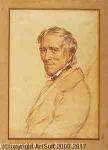William Westall
William Westall
Place: Hertford
Born: 1781
Death: 1850
Biography:
William Westall ARA was an English landscape artist best known as one of the first artists to work in Australia.
Westall was born in Hertford and grew up in London, mostly Sydenham and Hampstead. The son of brewery manager Benjamin Westall (d.1794) and his second wife Martha née Harbord, William Westall had four step-siblings, the eldest of whom, Richard Westall, was a reputable painter and illustrator. William was interested in painting from a young age; Rienitz and Rienitz (1963) suggest that he looked up to his half-brother, and was ambitious to follow in his footsteps. There is evidence to suggest that Westall's parents did not support this career choice; however Richard became head of the family upon the death of Benjamin Westall in March 1794, and must have approved Westall's artistic ambitions, as from that time forward William Westall was given a thorough art education. At the age of sixteen he won a silver palette in a competition run by the Society of Artists of Great Britain, and at eighteen was enrolled at the prestigious Royal Academy. :80–82
In 1800, whilst still a probationary student in his first year, Westall was approached by Sir Joseph Banks to serve as landscape and figure painter to a voyage of exploration under Matthew Flinders. The position had first been offered to Julius Caesar Ibbetson, who declined; and then William Daniell, but accepted but subsequently pulled out. Daniell was a fellow student of Westall, and was engaged to one of Westall's stepsisters, so it seems likely that Westall prevailed upon Daniell to recommend him as his replacement; however one source states that Westall was recommended by Benjamin West, President of the Royal Academy. :83–85 Elisabeth Findlay reconciles these claims by suggesting that Daniell "contrived" to have West put Westall's name forward.
Westall's nomination was approved by Banks; thus Westall, at just 19 years of age, was appointed to what has come to be regarded as one of the notable scientific expeditions ever undertaken, as a member of a team of scientists that included botanist Robert Brown and botanical artist Ferdinand Bauer, both now revered as amongst the very best in their respective fields.
Leaving London on 18 July 1801, the expedition reached Madeira, its first landfall, on 1 August. The following day Flinders, Brown and Bauer rowed to Bugio Island. The gardener Good records that he was not permitted to go with them, so instead he and Westall rowed around the Investigator in search of turtles and birds, obtaining one of each. A day later the Investigator anchored at Funchal, Madeira Island, and the following morning Westall went ashore with the other scientists, walking around Funchal and the vineyards north and east of the town. The next day the scientists went ashore again, with the intention of climbing the highest peak, Pico Ruivo. They walked all day, then spent an uncomfortable night in an unfurnished room in a chapel, probably the old chapel at Alegría. Early the next morning Westall returned alone to Funchal, the others continuing on for a few hours before turning back.
Westall was charmed by the island and seems to have been enthusiastic in his work. However, on returning to the ship, their boat was swamped, Westall was almost drowned, and all of his sketches were lost. This event seems to have profoundly affected him: it is claimed that he subsequently nearly died from exposure and stress, and even three years later he was claiming that "his head had been affected" by the accident. Throughout his life he maintained that the swamping was a deliberate act. :87–88
The next landfall was at Simon's Town, in the Cape Colony just east of the Cape of Good Hope. Anchoring in False Bay on 16 October, the Investigator remained eighteen days, during which time the scientists spent a good deal of time ashore. Nothing is known of Westall's movements in the first week, but Good, travelling with Brown, Bauer and ship surgeon Hugh Bell, reports falling in with him at Devil's Peak on 26 October, Westall having set out from Simon's Town with mineralogist John Allen two days earlier; the two men had become separated, and Westall had "fared very indifferently and slept one night at Constantia." The following day Westall accompanied Bauer and Bell towards Cape Town, while Good and Brown climbed Table Mountain. Good and Brown slept that night in the Tokai home of a German named Johann Gasper Loos, and woke in the morning to find Westall and Bell there too, the latter two having lost their way to Cape Town, and arrived at Loos' house late in the evening. All four men then returned to the ship together.
As with Madeira, Westall was delighted with the landscapes on offer at the Cape, and worked conscientiously, making some highly detailed sketches. Seven of Westall's field drawings from the Cape are extant. :87–88
The Investigator came in sight of Australia on 6 December, and the following morning Westall made his first sketch of Australia, a coastal profile from about 15 kilometres off Cape Leeuwin. He made two further coastal profiles the following day, one of Chatham Island (Western Australia), the other of the Eclipse Islands. Late that night the Investigator anchored alongside Seal Island in King George the Third's Sound (now King George Sound); they would remain in King George Sound for almost four weeks.
More...
Wikipedia link: Click Here














